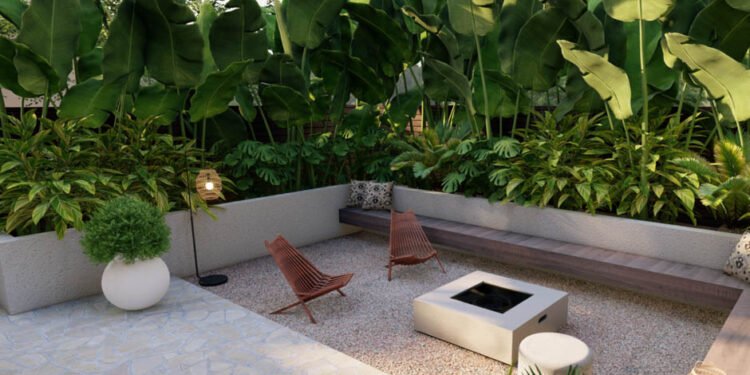When it comes to home improvement, landscaping is one of the most powerful tools homeowners can use to transform their outdoor spaces. Not only does it enhance the beauty of a home, but it can also provide much-needed privacy in today’s busy, interconnected neighborhoods. Striking the perfect balance between creating an attractive yard and a private sanctuary requires thoughtful design and a little creativity. In this article, we’ll explore how landscaping can serve the dual purpose of enhancing both home privacy and beauty, helping you create an outdoor space that’s both functional and visually appealing.
The Importance of Privacy in Outdoor Spaces
Privacy is a top priority for many homeowners, especially when it comes to outdoor spaces like backyards, patios, and gardens. Privacy is a top priority for many homeowners, especially when it comes to outdoor spaces like backyards, patios, and gardens, and Clark Outdoor Designs can create customized solutions to enhance your outdoor living experience. These areas are often used for relaxation, family gatherings, and recreation, making privacy crucial for creating a safe and comfortable environment.
Many homes, however, face common privacy challenges. Close neighbors, low fences, and open yards can leave homeowners feeling exposed, and traditional solutions like tall fencing aren’t always the most aesthetically pleasing. Fortunately, landscaping offers a natural, attractive alternative for boosting privacy without sacrificing beauty.
By carefully selecting plants, trees, and other landscape features, homeowners can effectively create outdoor spaces that feel like private retreats. This approach not only provides seclusion but also fosters a welcoming atmosphere filled with greenery and nature.
Landscaping Elements That Enhance Privacy
There are several landscaping techniques and elements that homeowners can use to create privacy. Here are some of the most effective and beautiful options:
Hedges and Shrubs
One of the simplest ways to create a natural privacy screen is by planting hedges or large shrubs. Plants like boxwood, privet, and arborvitae are excellent choices because they grow densely and can be shaped to fit almost any space. These evergreen shrubs provide year-round coverage, ensuring that your outdoor space remains private regardless of the season.
Trees
Tall trees can also be a great solution for enhancing privacy. Fast-growing varieties like cypress, spruce, or bamboo can quickly grow to a height that blocks unwanted views. By strategically placing trees along the edges of your property or near windows, you can create natural screens that offer both privacy and shade.
Fencing with Greenery
If you already have a fence but feel it’s not doing enough to ensure privacy, consider combining fencing with greenery. Planting vines like ivy, clematis, or honeysuckle along your fence line can soften its appearance while providing additional coverage. As these plants grow and spread, they’ll create a lush, natural barrier that blends beautifully with your landscape.
Living Walls
Living walls or vertical gardens are a popular trend, especially for smaller spaces like patios or balconies. These walls are made of vertical structures filled with plants, offering privacy without taking up much ground space. Living walls are both functional and beautiful, transforming blank walls into vibrant, living artwork.
Berm Landscaping
For homeowners looking for a creative and slightly more advanced landscaping solution, berms can be an excellent option. A berm is a raised mound of soil that can be covered with grass, plants, or flowers. By elevating the landscaping, berms create height and block sightlines, adding an extra layer of privacy. They also add depth and dimension to flat yards, making the landscape more visually interesting.
Enhancing Beauty Through Landscaping
While privacy is essential, the visual appeal of your yard is equally important. A well-landscaped yard can significantly improve your home’s curb appeal, making it more inviting to guests and potential buyers. Here are several ways to enhance your home’s beauty through landscaping:
The Visual Appeal of Greenery
Greenery, whether in the form of trees, shrubs, or flowers, naturally enhances the aesthetic of any outdoor space. Green plants add a sense of serenity and balance, while flowers introduce pops of color that can brighten the environment. By carefully choosing plants that complement one another, you can create a harmonious outdoor space that is both beautiful and functional.
Color Coordination
Choosing plants with complementary colors can help unify your landscape design. For example, pairing purple lavender with yellow daisies creates a visually striking contrast. Incorporating plants with different textures and shades can also add depth and interest to the garden.
Seasonal Beauty
To ensure that your landscape looks beautiful year-round, choose a variety of plants that bloom in different seasons. Spring bulbs like tulips and daffodils can bring early color, while summer perennials like roses and daylilies keep the garden vibrant in the warmer months. Fall can be brought to life with ornamental grasses and trees that display vibrant autumn foliage, while evergreens ensure that your garden remains lush during the winter.
Hardscaping
In addition to plants, hardscaping elements like walkways, patios, and decorative stones can add structure and beauty to your outdoor space. By combining hard materials with soft greenery, you can create a balanced look that feels natural yet refined. Water features, statues, and pergolas are also excellent hardscaping additions that enhance the overall design of the landscape.
Garden Layout
The layout of your garden plays a significant role in how it looks and functions. A well-designed layout should include a balance of open areas and structured plant groupings. Pathways that wind through gardens can guide the eye, leading visitors through the landscape while offering views of focal points like flower beds, water features, or sculptures.
When it comes to achieving beauty and privacy, All Around Property Maintenance offers landscaping services that help homeowners design and implement landscapes that are both functional and visually appealing. With their expertise, you can ensure your yard is not only private but also a stunning extension of your home.
Combining Privacy and Beauty for the Perfect Balance
The key to successful landscaping is finding the right balance between privacy and beauty. Here are some tips for achieving that perfect blend:
Layering Techniques
Layering plants of different heights and textures is an effective way to create both privacy and beauty. For example, you can plant tall trees or shrubs at the back of your yard, mid-sized plants in the middle, and smaller flowers or ground cover at the front. This creates depth and interest while blocking unwanted views.
Plant Selection
Choose plants that serve multiple purposes—offering privacy while also adding visual appeal. For example, ornamental grasses provide excellent coverage and sway gracefully in the wind, adding movement and texture to the garden.
Creative Design
Don’t be afraid to think outside the box when designing your landscape. Combining privacy features like pergolas or trellises with beautiful climbing vines creates a stylish, natural barrier. Similarly, water features or large boulders can provide visual interest while also creating a secluded feel.
Practical Tips for Landscaping Success
To make your landscaping efforts as effective and sustainable as possible, consider the following tips:
- Work with your yard’s natural features: Use slopes, natural stone, or existing trees to enhance privacy and beauty.
- Choose low-maintenance plants: If you don’t have time for constant upkeep, opt for hardy plants that thrive with minimal care.
- Hire a professional: For complex projects, consider consulting a landscape designer who can help bring your vision to life.
- Add lighting: Incorporating outdoor lighting not only enhances beauty but also increases nighttime privacy by illuminating areas selectively.
Conclusion
Landscaping is a powerful tool that can transform any outdoor space into a private, beautiful retreat. By carefully selecting plants, designing layouts, and incorporating hardscaping elements, homeowners can create a perfect balance between privacy and aesthetics. Whether you’re looking to increase your home’s curb appeal or simply enjoy your outdoor space in peace, landscaping offers endless possibilities for enhancing both beauty and privacy.












